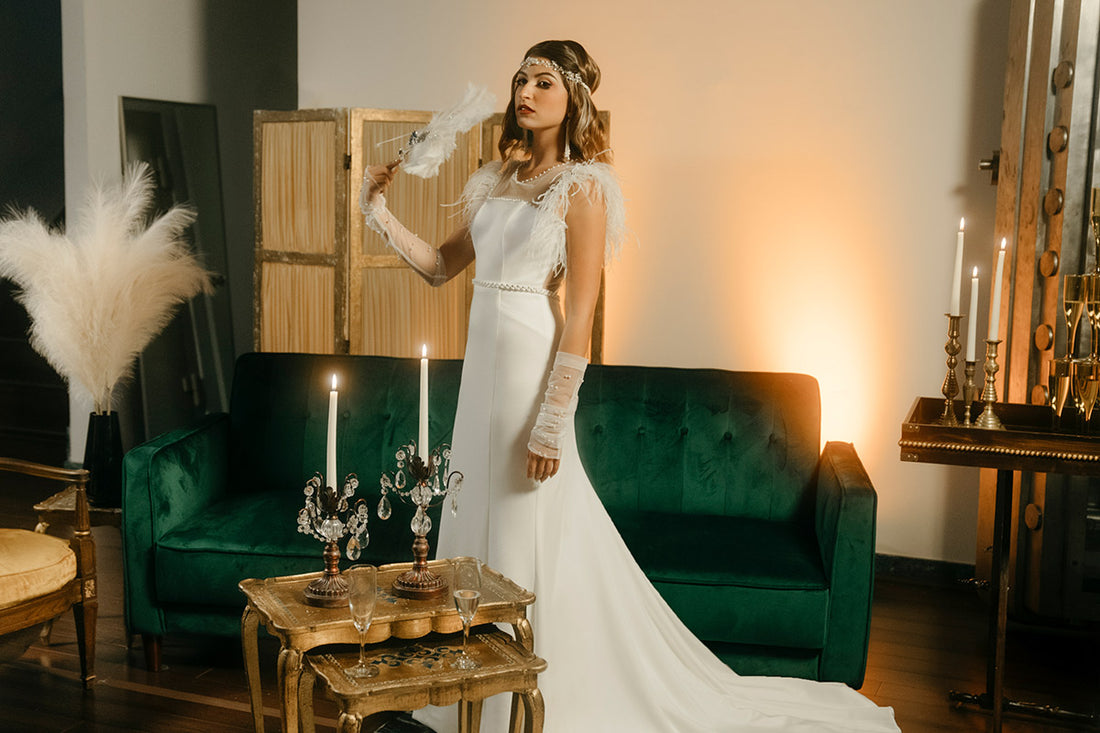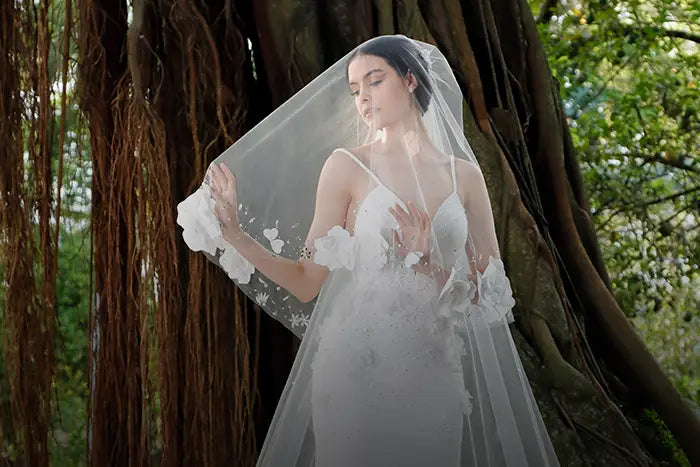
The Bride’s Guide to Gown Shapes
When we think of wedding dresses, many of us picture voluminous gowns with long trains flowing down the aisle.
That was the traditional image. But in the 21st century, brides are revolutionizing the wedding aesthetic. Wedding dresses now come in a wide variety of shapes and styles, from stunning ballgowns inspired by Victorian-era romance to elegant sheaths revealing the goddess within.
Let’s explore some of the most popular shapes for bridal gowns, along with which styles are best for your unique aesthetic!
Ballgown
Named for its origin in 19th-century regency balls, this gown shape features a round, highly layered skirt that also looks a bit like a ball. The dramatic skirt contrasts with a slim-fitting, low-cut bodice. In the Victorian era, it was popular to wear a corset to create a dramatic hourglass shape. Off-the-shoulder sleeves highlighted the wearer’s neck and shoulders while balancing the skirt’s wide silhouette.
This wedding gown shape is ideal for any bride who wants to show off her décolletage or toned shoulders. It has a classically romantic vibe that instantly creates glamour.
Today’s wedding dresses don’t require a corset or bustle to achieve the famous ballgown shape. This makes them much more comfortable to wear!


Mermaid
The mermaid gown shape emerged during the Golden Era of Hollywood. These sleek silhouettes taper down to the knees or shins, where a glorious skirt makes a mermaid-tail shape. The style emerged as Hollywood stars dared to show off their physique even during the conservative Production Code era. It was not acceptable for women to reveal their legs. But the mermaid gown highlighted their natural hourglass figures without restricting their movement.
Designer Marcel Rochas created the first mermaid gown in the 1930s. Celebrities quickly adopted the style as it was perfect for the red carpet. Actresses such as Marilyn Monroe and Rita Hayworth made the mermaid gown an icon of Hollywood fashion.
Today, many wedding dresses feature the mermaid silhouette. The fluffy skirt, often made of taffeta or organza, adds whimsical glamour to a flattering shape. Mermaid gowns often feature a tailored, strapless bodice to counterbalance the dramatic fishtail.
A mermaid-style wedding dress looks wonderful on brides with a curvy physique thanks to its form-fitting silhouette. The fishtail shape complements a large bust while creating a gentle flow down the aisle.


Trumpet
Similar to the mermaid shape, a trumpet gown has a slim silhouette with a flared skirt. But while mermaid dresses are usually strapless, the trumpet gown has straps or cap sleeves. The bodice has a fitted waistline at which the skirt begins, flaring out at the knees. So, this style is also called “fit and flare.”
The trumpet shape is ideal for brides with wider hips and narrower shoulders. The “fit and flare” flatters the curves and creates more of an hourglass look.


A-Line, Princess, and Tea-Length
The A-line gown shape features a full skirt and a fitted bodice, usually with a decorative waistline. It’s similar to the ballgown shape but less round and more angular, like an “A.”
Some wedding gowns fall in between the voluminous ballgown and classic A-line. This shape is sometimes called a “princess” gown, which gives that dreamy fairy-tale look without overwhelming smaller physiques.
One common variation of A-line wedding gowns is the tea-length dress. The full skirt ends just below the knees. This flirty style hearkens back to mid-century American fashion.
No matter how much length or “poof” an A-line gown has, it’s sure to make the bride feel like a princess! Plus, it’s flattering for just about any body shape.


Sheath
Also called “slip,” the sheath dress flows down the body for a lovely silhouette. This simple shape lends itself to a variety of necklines, from sweetheart to cowl to a plunging V-neck.
Sheath-style wedding gowns are versatile enough to take the bride from the ceremony to the last dance. They often feature dazzled beadwork and embroidery to add glamour without so many layers and ruffles.
Shorter brides look tall and statuesque in the sheath shape.


Column
This elegant dress shape is reminiscent of Greco-Roman goddesses. It’s slim-fitting like the sheath gown but often features draped or gathered layers around the torso.
Brides who wish to look taller will love the column gown shape. It’s also ideal for those with a pear body shape, as the visual interest at the shoulders balances out wide hips.


Empire
The empire waistline emerged in early 19th-century fashion. In this style, the skirt begins just below the ribcage. The bodice fits snugly around one’s bust and may be sleeveless or strapless. Some gowns feature a lacey or embroidered yoke to draw attention to the wearer’s arms and shoulders.
Brides with athletic physiques or a rectangular body shape usually look curvier in an empire gown.
The romantic full skirt counterbalances the fitted bodice, highlighting the bride’s décolletage and making her appear statuesque.



